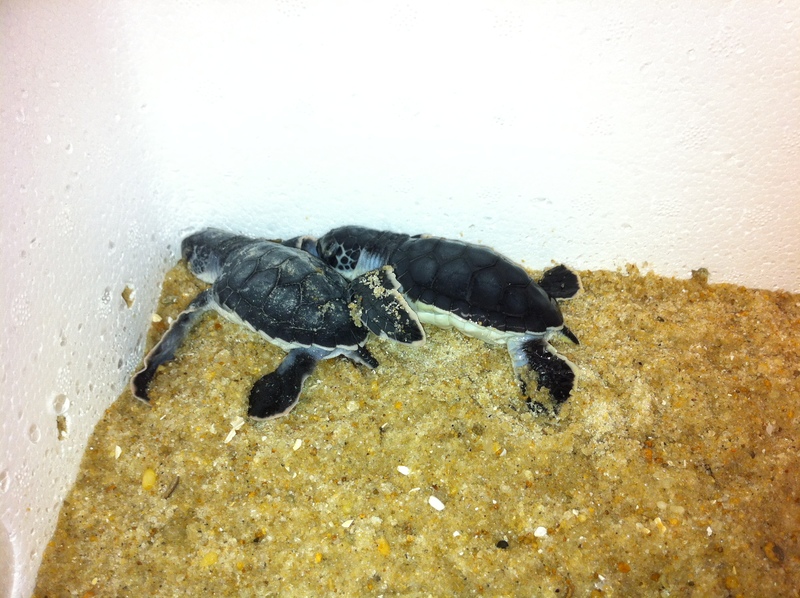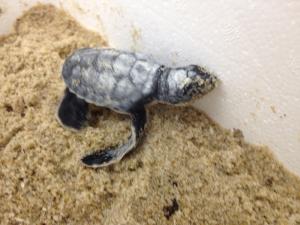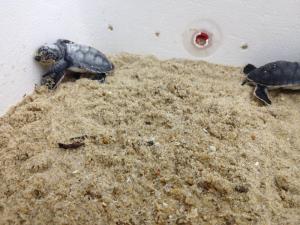Few gave them any chance, but at least three baby sea turtles from a clutch of eggs laid last summer have hatched.
"It was the most amazing thing to see," said Suzanne Thurman, director for the MERR Institute, a sea-life rescue organization that has been involved since the eggs were first found last summer. "I've never seen such joy on the volunteers faces. I wish I had a camera to capture their smiles."
MERR volunteer Janice Pinto of Lewes was the first to notice two tiny turtles crawling around the sand nest that had been their home since Aug. 18.
"They would scoot about and then rest," Pinto said. She called Thurman Sunday and jotted down in the turtle time-check sheet, "We have turtles yahoo!"
"All your academia and training goes out the window at a time like that," she joked.
Thurman said she watched a third turtle hatch and wiggle free of its shell Sunday night.
The 194 eggs in the clutch made history as the first documented nest of green sea turtle eggs in Delaware. It's rare for any type of sea turtle to nest this far north along the Delaware shore; until this summer no one had ever seen a green sea turtle nest in Delaware.
Turtle or sandcastle?
Cpl. Keith Betts of Cape Henlopen State Park Patrol came upon the mother sea turtle covering up her nest with sand during his early morning rounds at Herring Point.
"All along the beach in the summertime, it's holes and sandcastles, holes and sandcastles," he said. "She looked like a sandcastle at first."
But now that he knows what a freshly made sea turtle nest and sea turtle tracks look like, Betts said, he'll know what to look for in the future.
Normally, Thurman said sea turtles lay eggs no further north than North Carolina. From there, it's much easier for the baby turtles to reach the Gulf Stream and follow the current south.
For that reason, North Carolina is the baby turtles' next destination. But they won't be swimming there, Thurman said. Instead, a Department of Natural Resources and Environmental Control van will transport the three little ones and the eggs that haven't hatched. Extra containers will be brought to hold any new turtles hatched during transportation, a highly probable scenario, Thurman said.
Journey has only just begun
Plans are to leave Tuesday morning for a facility in the Outer Banks that handles sea turtle incubation. Baby turtles then most likely will be taken by boat out to the Gulf Stream where they will be let free. From there, they will swim to the Sargasso Sea, a plant and nutrient-filled area where they can rest and fortify themselves as they make their way to the warm Caribbean waters.
Thurman said there have been skeptics from the very beginning, even from the U.S. Fish and Wildlife Service, which doubted the eggs would survive the first move. The first nest was laid too close to the shoreline; Thurman said the eggs would not have survived the high tide. Volunteers dug up the first nest and moved the eggs up the beach where they protected them with a chicken-wire cage. There the eggs endured Hurricane Irene and bucket-loads of sand.
When temperatures dropped in September, DNREC officials and MERR volunteers moved the eggs to a climate-controlled room at the University of Delaware School of Marine Science and Policy. A dozen dedicated volunteers took shifts checking for movement and adjusting temperatures.
Few believed eggs could survive
"I was truly one of the ones who thought it might not happen," said Julie McCall of Broadkill Beach.
She's now one of those celebrating.
Thurman said she's relieved she had happy news to share, especially during the holiday season.
"It's life, and it's something we nurtured and brought to life," she said. "Live animals help keep us going."
To see a live turtle cam, go to merrinstitute.org.
Melissa Steele is a staff writer covering the state Legislature, government and police. Her newspaper career spans more than 30 years and includes working for the Delaware State News, Burlington County Times, The News Journal, Dover Post and Milford Beacon before coming to the Cape Gazette in 2012. Her work has received numerous awards, most notably a Pulitzer Prize-adjudicated investigative piece, and a runner-up for the MDDC James S. Keat Freedom of Information Award.



























































